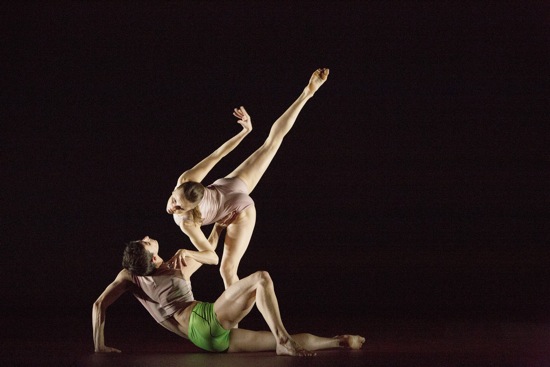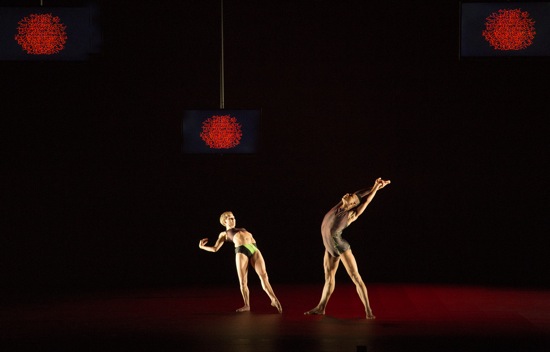Wayne McGregor/Random Dance brings Atomos to Peak Performances at Montclair State’s Alexander Kasser Theater.
Wayne McGregor wants it both ways, and I don’t blame him. This virtuoso dancemaker— resident choreographer at Britain’s Royal Ballet, the director of Wayne McGregor/Random Dance, and a been-around whose works grace the repertories of numerous companies—wants us to look at his dances and not worry about how they were made, but he also want to tell us, via published interviews, how they were made. So, naturally the complexities of his processes haunt us, but obviously, they haunt the work too.
This feeling was generated by his Atomos, which received its American premiere at Montclair State University as part of the terrific Peak Performances series. I am, of course, interested in cognition and biometrics and robots programmed to generate movement material. (Sometimes, too, I ponder my own unknowable atoms that fight and hook up and die while the entity known to me as “I” goes about its business.) But much current science is outside my ken, and McGregor’s statement re Atomos to Robert Johnson of The Star-Ledger gives me a helpful image with which to coordinate my impressions: “The whole piece is about pixelating a world.”
The details of McGregor’s research and processes do, however, reinforce my impression of him as a serious experimenter in movement and movement systems, and not simply a man who wants to deconstruct the dancerly body and its body of received knowledge for the hell of it—to see what fantastic and thrilling contortions he and the members of Random Dance can come up with. In his seriousness and his explorations with the body, inside and out, he can be grouped with Ohad Naharin and William Forsythe (although the three have very unlike aesthetics). The pathways of the digital world, its speed, and its intricacies, and developments in the field of microsurgery make such investigations very relevant. (As I write these words, hostile bots have invaded the website on which I expect to post this review, and it is proving difficult to track and immobilize them).
However you choose to view Atomos, it’s a spectacle produced by ten uncannily flexible dancers, handsomely colored lighting by Lucy Carter, a dazzling media component by Ravi Deepres, and a wonderfully variegated score by A Winged Victory for the Sullen: Dustin O’Halloran and Adam Wiltzie (piano, guitar, electronics) and played live by them plus members of the American Music Ensemble; Laura Luzke (violin), Keats Dieffenbach (violin), Neil Leiter (viola), Clarice Jensen (cello), and Brian Snow (cello).
Those of us sitting in Montclair State’s Alexander Kasser Theater during Random Dance’s March season there get our first glimpse of McGregor’s company members as a fluctuating horde, clustered under a spotlight. Within the clump, individuals bend or straighten, lean, undulate their spines, perhaps lift one another—all conveying seemingly spontaneous impulses. As the beam of light widens, and green rays strike them from the sides of the stage, the dancers’ skills become apparent. Their backs are super-flexible; you’d think them either boneless or harboring a smidgen of snake DNA. Both men and women are crotch-sprung, able to lift their legs unnaturally high. Sometimes their resilient muscularity has a simian quality; sometimes, they crook every joint and make you think of grasshoppers.
What’s intriguing is that their virtuosity (despite the jumps of all kinds that they whip off and the occasional near-balletic pirouette) is predicated on rippling and tangling themselves into positions and maneuvers that derange human physicality as we’re used to seeing it, while at the same time, McGregor organizes them into elegantly tidy patterns. For instance, at one point, the dancers form two chains, one facing the audience, one facing away from it. Partners moving in perfect synchrony cross the stage; other couples, entering from different sides, follow suit, one pair at a time. McGregor is skillful at contrasting diversity and uniformity, fluidity and stop-action.
This community encourages coupling. Some of its members watch while Fukiko Takase and Travis Clausen-Knight do things to each other, angling into knotty positions, creating interstices for the partner’s limbs to poke through. None of this seems erotic or even intimate. The duet has the air of an investigation. In fact, all the movement does. When the marvelous Alvaro Dule explores a set of extreme maneuvers, he does so without appearing to show off or win our applause. He lifts his leg improbably high with the concentration of a worker calibrating a difficult balance of elements.
In the middle of the work, seven screens of various sizes descend from above into what is now an all-red room. This is our cue to don the 3-D spectacles we were given on entering the theater. Dule is dancing with Anna Nowak, but who can watch them closely? Although the choreography continues—by them and by others—the décor comes to life and dominates the stage. While a burst of drastic noise and what sounds like a volcanic eruption ensues, the screens absorb and dislodge patterns. Because of the glasses, we see little red squares breaking free and coming toward us; then, before we instinctively duck, they retreat into the big red rectangle that they were part of.
I was lying; we do see the dancers; at one point, the screens even show their images. Five couples dance simultaneously, each with its own agenda. Catarina Carvalho and Michael-John Harper overlap Dule’s solo with a jittery duet. But the live performers have eye-catching accomplices during this section of Atomos. Green writing that advances and retreats. Sequences of numbers appear. Huge green bugs crawl over each screen; as they multiply, they diminish in size, until the screens show what looks like dense, throbbing hedgery. A bank of red lights descends, stays a while, and lifts. Jessica Wright and Louis McMiller communicate their extravagant corporeal messages beneath what look like giant, luminous, red chrysanthemums, hanging like chandeliers.
In the end, the seductive media blitz ends its pixelating and reassembling of images, and we concentrate again on these the phenomenal, dispassionate dancers (not mentioned yet: Daniele Neugenbauer and James Pett). The fine music, whose intermittent melodies help remind us of their humanity, dies away. And what are we left with? Beauty and strangeness and ideas that still whirl in fragments within our unknowable brains.





It seems that the more we learn about our universe, from the very big to the very small, the more we want to create art that uses the body as just one element of many. I haven’t been able to watch Cuaron’s “Gravity” (I get queasy with 3D) but I’m told that one of its most powerful aspects is its ability to reduce our size while retaining our humanity — I think that’s the hardest trick of all, and wonder if that had any place in this work.
As ever, your writing brings the work to life on a stage in my mind. I see all the actions and effects you describe and some you don’t played out in an abbreviated, private version. Thank you for that.
When the company performed in Santa Barbara earlier this year (not Atomos), I was impressed by the strength, focus and facility of the dancers and by the anatomical complexity of the choreography. Blame it on my training or philosophical standpoint, but I missed breath.